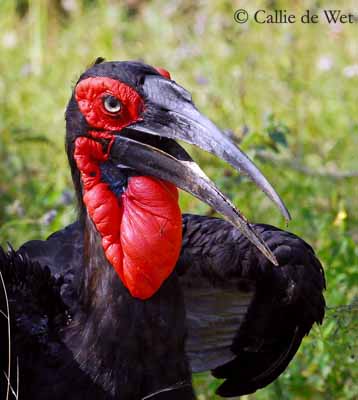
Fr: Bucorve du Sud
Ang: Southern Ground-Hornbill
All: Kaffernhornrabe
Esp: Cálao Terrestre Sureño
Ital: Bucorvo cafro
Nd: Zuidelijke Hoornraaf
Sd: sydlig hornkorp
Photographers:
Callie de Wet
GALLERY
Didier Buysse
Vision d’Oiseaux
Steve Garvie
RAINBIRDER Photo galleries
Text by Nicole Bouglouan
Sources:
HANDBOOK OF THE BIRDS OF THE WORLD Vol 6 by Josep del Hoyo-Andrew Elliott-Jordi Sargatal - Lynx Edicions, 2001 - ISBN: 848733430X
BIRDS OF AFRICA SOUTH OF THE SAHARA by Ian Sinclair and Peter Ryan - Princeton University Press Princeton and Oxford - ISBN: 0691118159
L’ENCYCLOPEDIE MONDIALE DES OISEAUX - Dr Christopher M. Perrins - BORDAS - ISBN: 2040185607
Animal Diversity Web (University of Michigan Museum of Zoology)
UNIVERSITY OF CAPE TOWN - Southern Ground-Hornbill conservation
Wikipedia (Wikipedia, The Free Encyclopedia)
CREAGUS@Monterey Bay (Don Roberson)


Southern Ground-Hornbill
Bucorvus leadbeateri
Bucerotiformes Order - Bucorvidae Family
INTRODUCTION:
The Southern Ground-Hornbill is one of the two members of the family Bucorvidae which gathers the two largest species of hornbills. It can be found from Kenya to South Africa where it frequents woodlands and savannas.
It is carnivorous and finds most of the food while hunting on the ground. The food ranges from insects to mammals, but reptiles, amphibians, snails and small mammals are also part of the diet.
This large bird usually nests in tree holes or rock crevices. It is a cooperative breeder and is often assisted by at least two helpers. The young depend on adults for food for one or two years after fledging.
The Southern Ground-Hornbill is threatened by loss of nesting habitat caused by clearance, agriculture expansion and fires or storms. Despite being described as common and widespread but sparse, the species is currently listed as Vulnerable.
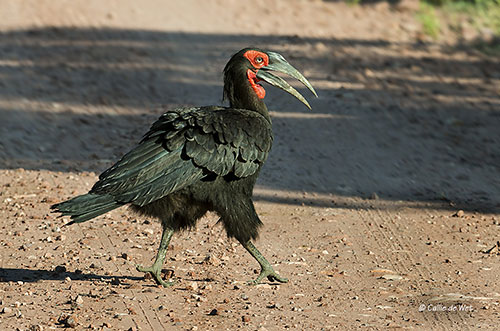
DESCRIPTION OF THE BIRD:
Biometrics:
Length: 90-130cm
Weight: M: 3500 to 6200 g - F: 2250 to 4600g
The Southern Ground-Hornbill has black plumage and typical red-facial skin. It is a large black bird, with white primary flight-feathers conspicuous in flight.
The male has bare, bright red facial skin and bare, inflatable throat skin.
The large bill is black, down curved and powerful, with a hollow casque above, probably playing some role in displays or male selection. This casque is more developed in males than females.
The eyes are pale grey-green. Legs and feet are strong and black.

The female is smaller than male. She has a violet blue patch on the red throat skin, and this colour may sometimes cover most of the lower parts of her face.
The chicks hatch with pink skin, turning black within three days.
The juvenile has pale grey pinkish-brown facial skin, and is browner than adults. It is mature at 4-6 years old.
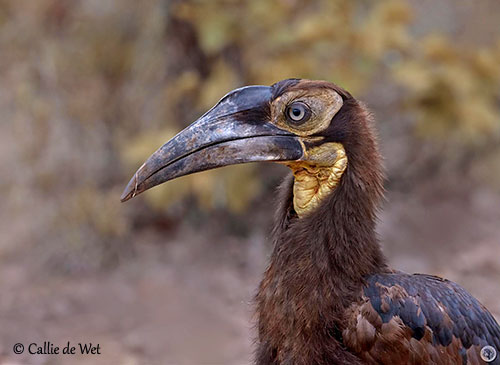
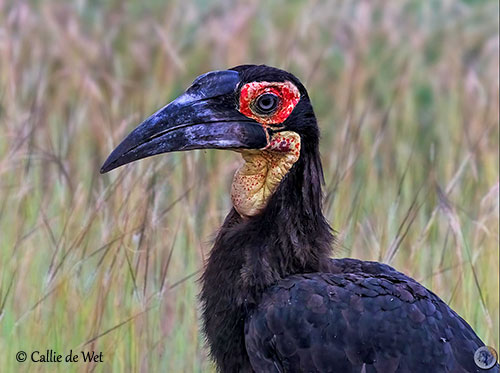
RANGE:
The Southern Ground-Hornbill is found in Africa, from Kenya to South Africa. Its range extends from the equator to the southern tip of the continent. It occurs in S Kenya, and Rwanda S to DR Congo, Angola, N Namibia, N and E Botswana, and then in NE and E South Africa, mainly S of Eastern Cape.
HABITAT:
The Southern Ground-Hornbill lives in savannas and woodlands. It needs large trees for nesting, and open, grasslands close to forest patches with dense but short grass for foraging. It often prefers moist habitats. The species can be found up to 3000 metres of elevation in east Africa.
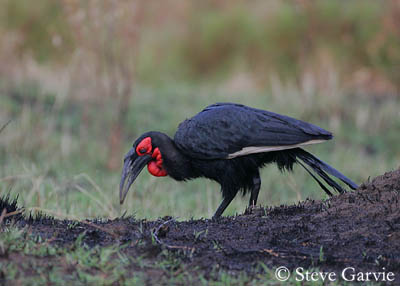
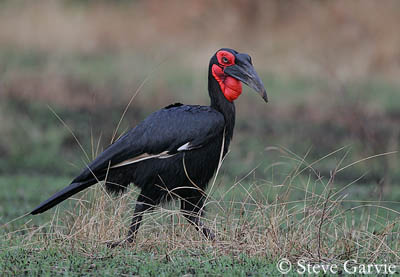
CALLS AND SONGS: SOUNDS BY XENO-CANTO
The Southern Ground-Hornbill gives strong calls at dawn while defending the territories in small groups. The alarm call is a deep grunt. To scare off predators, they also produce loud calls by filling and releasing air from the air-sacs.
During the breeding season, the male produces loud “booming” calls, and we can hear series of low-pitched sounds “ooh…ooh…ooh…ooh…” However, male and female calls are slightly different, involving duets.
This species is more vocal in the early morning and the late afternoon.
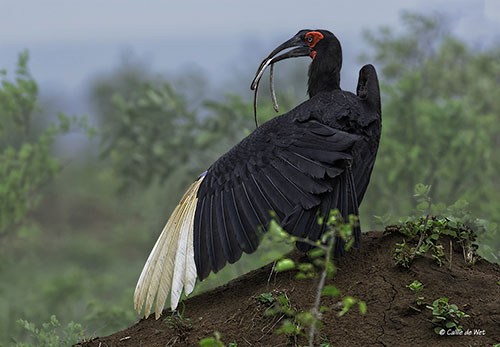
BEHAVIOUR IN THE WILD:
The Southern Ground-Hornbill is carnivorous. It feeds on lizards, frogs, snails and insects (grasshoppers, beetles and termites), but also on small mammals, such as hares and squirrels, and also snakes.
It may consume some vegetation (fruit and seeds) and it feeds sometimes at carrion.
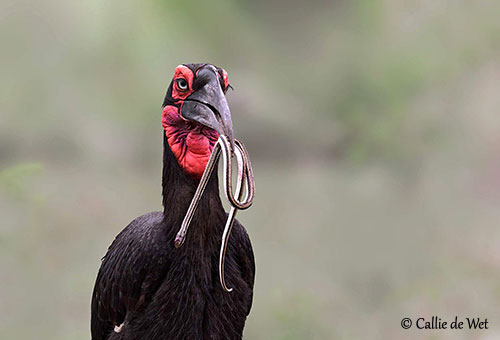
It spends most of its time walking slowly on the ground while searching for food, mainly small animals and insects. It walks with stubby toes elevated, almost on tip-toe. It forages on the ground by digging with the bill for food. But when hunting more difficult prey such as snakes, they usually form groups.
The Southern Ground-Hornbill uses its powerful bill to kill the prey and slice the food. The large prey are pursued and dismembered by several group members.
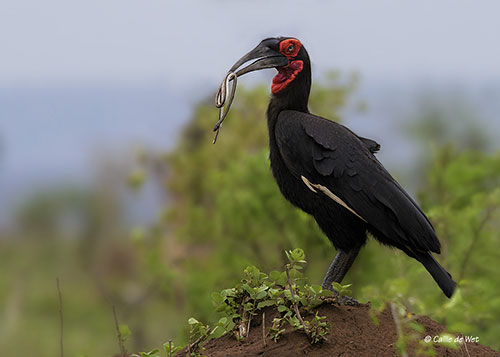
This species is very active and always moving. They live in groups of up to 2 to 12 birds. They occupy and defend large territories of up to 100 square kilometres, but much smaller in some parts of the range.
These groups include a single breeding pair or a dominant breeding pair with helpers of various ages, often adult males and immature of both sexes. Most breeding pairs remain monogamous throughout their lives.
They defend territories against other groups, chasing each other in aerial pursuits. In typical territorial behaviour, it may attack its own reflection in glasses of houses or cars, breaking them.
They usually roost in trees.
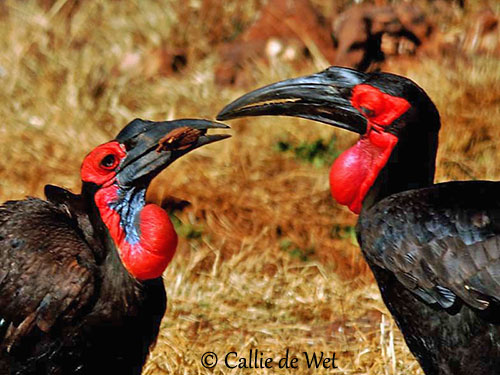
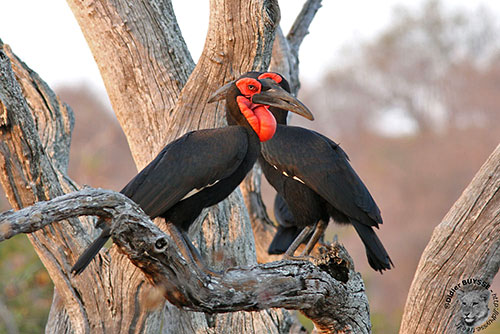
The adult female may move to other close group or live solitary, near mammals.
They are sedentary but they disperse at maturity, especially the females.
The Southern ground-Hornbill performs aerial pursuits when it defends the territory, and intruders are chased over long distances, up to 3 kilometres.
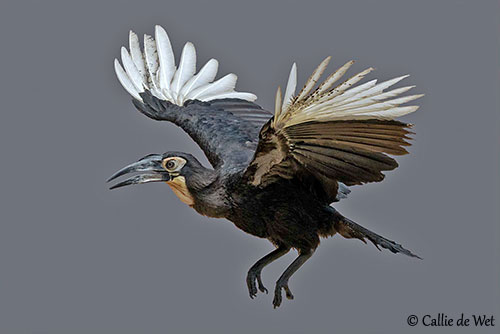
REPRODUCTION OF THIS SPECIES:
The Southern Ground-Hornbill breeds from September to December. It nests in natural cavities and holes, in dead or live trees, or in rock crevices in cliffs. This species doesn’t seal the nest entrance. Once the female is fertilized, she enters the nesting sire prepared by the male. It is lined with dry leaves and grasses. She is protected by her mate while nesting, and she is fed by the male and the helpers during the incubation.
The female usually lays two white eggs, but only one chick is raised. The incubation lasts about 37-43 days, by the female alone, but she is fed by the male and the group members.
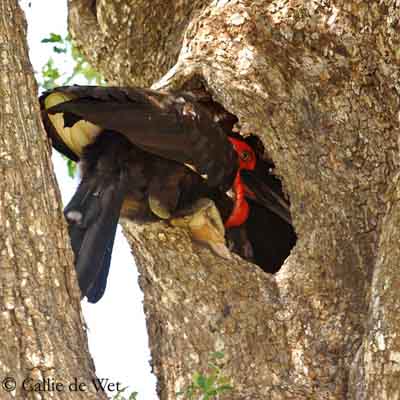
The first egg hatches about 3 to 5 days before the second. The first chick weighs about 250 grams when the second hatches, weighing only 60 grams. The oldest chick out-competes its younger sibling for food. The youngest chick starves to death within the first week.
The remaining chick is fed 4 to 9 times a day by group members carrying variety of food in the bill tip. During the nesting period, members of the group help the nesting pair and provide food. The young fledges about 86 days after hatching. The juvenile still depend on adults for several months, sometimes one year or more.
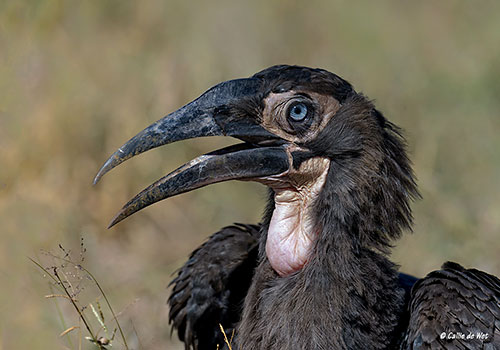
PROTECTION / THREATS / STATUS:
As the Southern Ground-Hornbill raises only one chick, the conservationists collect the hatchlings left to starve, and they raise them by hand-reared, to make them available for re-introduction. This hand-rearing of Southern Ground-Hornbill hatchlings is part of wide ranging projects in South Africa.
This species is mainly confined to national reserves and parks. Its habitat is threatened by human development involving habitat loss. However, it is fairly common and widespread, except in some areas of South Africa and Zimbabwe.
But this hornbill may also be killed for traditional rituals, especially against drought. On the other hand, as it has a high cultural importance, the species is well protected.
Collisions with powerlines and electrocution on transformer boxes are some of the usual threats, exacerbated by the slow reproductive rate and maturation of the species that may involve threat of decline.
The size of the population is unknown but the species is fairly common and widespread (although sparse), but some decline is suspected. Studies are in progress.
The Southern Ground-Hornbill is currently listed as Vulnerable.
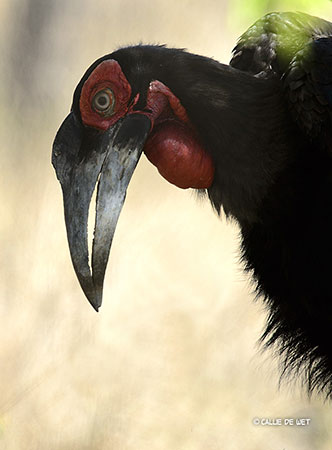
Courtship display.
The female offers some gift to the male